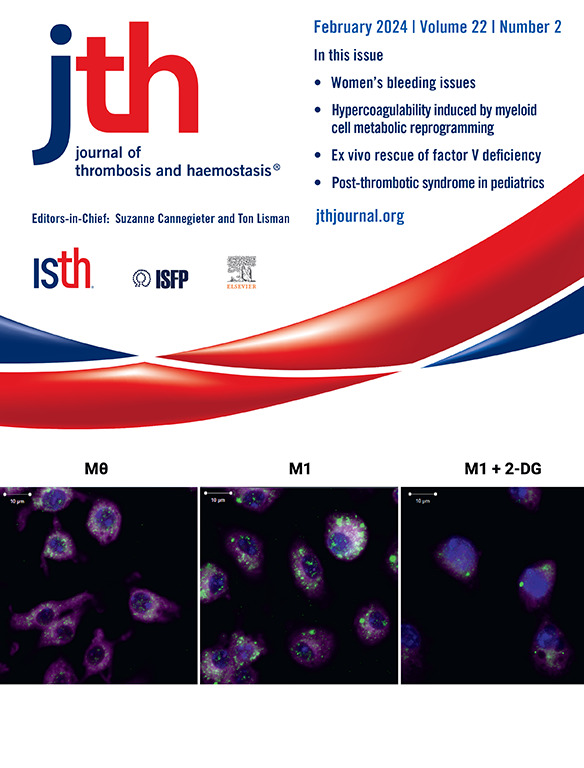Elevated levels of (active) von Willebrand factor during anticoagulation are associated with early recurrence of venous thromboembolism
IF 5
2区 医学
Q1 HEMATOLOGY
引用次数: 0
Abstract
Background
Venous thromboembolism (VTE) can recur shortly after stopping anticoagulation, highlighting the need for reliable biomarkers to identify high-risk patients during treatment.
Objectives
To determine whether platelet and endothelial markers predict VTE recurrence.
Methods
We used data and samples from the randomized controlled VISTA trial (2011-2015), which included patients with unprovoked VTE who were treated with vitamin K antagonists for 6 months. After treatment cessation, patients were followed for 2 years to assess recurrence. This dataset formed the basis for the current prospective analysis, in which plasma levels of von Willebrand factor (VWF), active VWF (aVWF), soluble P-selectin, soluble thrombomodulin, CXCL4, and CXCL7 were measured before and after cessation of anticoagulation. Associations between biomarker levels and recurrence were analyzed using Cox regression.
Results
Plasma samples from 629 patients with a first unprovoked VTE who discontinued vitamin K antagonists were analyzed. Recurrence occurred in 75 patients (12%); 11 (15%) within 1 month, 29 (39%) within 3 months, and 46 (61%) after 3 months. Elevated levels of VWF and aVWF were associated with an increased risk of recurrence per 10-unit increase (VWF: hazard ratio, 1.03; 95% CI, 1.01-1.06; aVWF: hazard ratio, 1.02; 95% CI, 1.00-1.05). Associations were stronger for early recurrence (<3 months), while (a)VWF levels were not associated with late recurrence (>3 months). Stratification showed that VWF and aVWF were associated with increased recurrence risk in men, but not in women.
Conclusion
Elevated levels of VWF and aVWF during anticoagulation were associated with early recurrence in men and might serve as biomarkers for predicting VTE recurrence.
抗凝期间血管性血友病因子水平升高与静脉血栓栓塞的早期复发有关。
背景:静脉血栓栓塞(VTE)可在停止抗凝治疗后不久复发,因此需要可靠的生物标志物来识别治疗期间的高危患者。目的:确定血小板和内皮标志物是否能预测静脉血栓栓塞复发。方法:我们使用随机对照VISTA试验(2011-2015)的数据和样本,其中包括接受维生素K拮抗剂(VKA)治疗6个月的非诱发性静脉血栓栓塞患者。停止治疗后,患者随访两年以评估复发情况。该数据集构成了当前前瞻性分析的基础,其中在停止抗凝治疗前后测量血浆VWF、aVWF、可溶性p -选择素、可溶性血栓调节素、CXCL4和CXCL7的水平。使用Cox回归分析生物标志物水平与复发之间的关系。结果:分析了629例首次非诱发性静脉血栓栓塞患者停用VKA后的血浆样本。75例(12%)患者出现复发;1个月内11例(15%),3个月内29例(39%),3个月后46例(61%)。VWF和aVWF水平升高与每10个单位增加的复发风险增加相关(VWF: HR: 1.03, 95%CI: 1.01-1.06;aVWF: HR: 1.02, 95%CI: 1.00-1.05)。早期复发(3个月)的相关性更强。性别分层显示,VWF和aVWF与男性复发风险增加有关,但与女性无关。结论:抗凝期间VWF和aVWF水平升高与男性静脉血栓栓塞的早期复发有关,可能作为预测静脉血栓栓塞复发的生物标志物。
本文章由计算机程序翻译,如有差异,请以英文原文为准。
求助全文
约1分钟内获得全文
求助全文
来源期刊
CiteScore
24.30
自引率
3.80%
发文量
321
审稿时长
1 months
期刊介绍:
The Journal of Thrombosis and Haemostasis (JTH) serves as the official journal of the International Society on Thrombosis and Haemostasis. It is dedicated to advancing science related to thrombosis, bleeding disorders, and vascular biology through the dissemination and exchange of information and ideas within the global research community.
Types of Publications:
The journal publishes a variety of content, including:
Original research reports
State-of-the-art reviews
Brief reports
Case reports
Invited commentaries on publications in the Journal
Forum articles
Correspondence
Announcements
Scope of Contributions:
Editors invite contributions from both fundamental and clinical domains. These include:
Basic manuscripts on blood coagulation and fibrinolysis
Studies on proteins and reactions related to thrombosis and haemostasis
Research on blood platelets and their interactions with other biological systems, such as the vessel wall, blood cells, and invading organisms
Clinical manuscripts covering various topics including venous thrombosis, arterial disease, hemophilia, bleeding disorders, and platelet diseases
Clinical manuscripts may encompass etiology, diagnostics, prognosis, prevention, and treatment strategies.

 求助内容:
求助内容: 应助结果提醒方式:
应助结果提醒方式:


